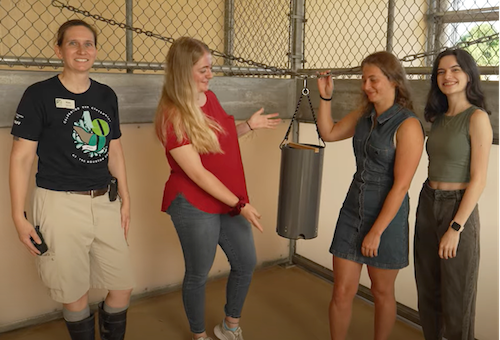Just steps away from Rice University, you can meet Neptune, Luna, Vidalia, Artemis and Ophelia, the Houston Zoo’s resident red river hogs.
In the wild, red river hogs spend about 80% of their time foraging for food. At the zoo, it’s important for these incredibly smart animals to have engaging feeders that challenge them to hunt.
That’s where Rice’s Intro to Engineering Design course comes in.
Over the years, the university and its Oshman Engineering Design Kitchen have partnered with the zoo on a number of projects, from a fish-rewarding enrichment device for sea lions to a protective brooder box for exotic baby birds . The Red River Bandits team — made up of rising sophomores Eleanor Kimbro, Alice Owens and Amanda Simpson and rising junior Tori Payne — was charged with designing a new feeder for the hogs.
“We love to partner with the Rice engineering program,” said Kim Siegl, a keeper in the hoofstock department at the zoo. “The students come up with different ideas and ways of building projects that are beyond my personal ability as a zookeeper to think of and have the construction abilities to do.”
"This project has been a great opportunity to apply four original perspectives to a tangible and practical design project,” Simpson said.
The Red River Bandits designed a multilevel feeder made of PVC pipe, with cord that allows it to hang and easily be accessed by the hogs. The device is constructed to distribute food when the animals engage with it.
“The hogs are supposed to hit the bottom of the device in which the feed pellets from the very top distribute throughout the circular levels in the holes that are 180 degrees apart from each other, to be able to distribute throughout the bottom holes of the device,” said Payne, a biosciences major.
“The feeding time with some of the current feeders, which are rolling feeders that the hogs push around to distribute food, takes about five minutes,” said Owens, a mechanical engineering major. “What Kim really wanted from us was a feeder that was going to elongate that feeding time, if possible, up to about 15 minutes while increasing their physical activity.”
“There are obviously unique challenges with every project, and the biggest one for us was not knowing exactly how our users, the hogs, would interact with the device,” said Kimbro, a bioengineering major.
Although the hogs were a bit nervous to use the feeder for the first time, a reaction Siegl said was normal, they eventually engaged with the device. The students hope that over time it will become a regular part of their feeding routine.

